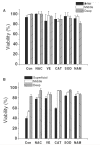Antioxidants block cyclic loading induced chondrocyte death
- PMID: 17907423
- PMCID: PMC2150661
Antioxidants block cyclic loading induced chondrocyte death
Abstract
Articular cartilage in congruous joints benefits from the moderate stresses and strains associated with normal cyclic loading. However, loading of joints with surface incongruities can lead to local stress and strain elevation at "step-off' sites where cartilage is not fully buttressed b ysurrounding matrix. Excessive stresses and strains predicted to occur at such sites may induce apoptosis, a process thought to promote cartilage degeneration and osteoarthritis (OA) through chondrocyte attrition. We hypothesized that the induction of apoptosis is mediated by oxidants, and that antioxidants can reduce elevated stress-induced chondrocyte attrition. To test this we exposed cylindrical cartilage explants from human articular cartilage to radially unconfined cyclic axial compression (3600 cycles, 1 Hz, 50% duty cycle) using two different physiologic loads (2MPa and 5 MPa). We found that 30% of chondrocytes in the superficial zone died within 24 hours of exposure to loading with 5 MPa axial compression, whereas mortality was limited to less than 15% with 2 MPa axial compression. Similarly, lactate accumulation in the medium was suppressed by compression with 5 MPa, but not 2 MPa. Approximately 80% of cell death induced by 5 MPa compression was blocked by pre-incubation of the explants in a variety of anti-oxidants including vitamin E, n-acetyl cysteine (NAC), and a superoxide dismutase mimetic (SOD). SOD and NAC also prevented the suppression of lactate secretion after 5 MPa compression. These observations support the hypothesis that the harmful effects of abnormal cyclic loading are mediated by oxidants and suggest that treatments to prevent OA may include methods of minimizing oxidative damage to chondrocytes.
Figures





Similar articles
-
Oxidant conditioning protects cartilage from mechanically induced damage.J Orthop Res. 2010 Jul;28(7):914-20. doi: 10.1002/jor.21072. J Orthop Res. 2010. PMID: 20058262 Free PMC article.
-
Injurious mechanical compression of bovine articular cartilage induces chondrocyte apoptosis.Arch Biochem Biophys. 2000 Sep 15;381(2):205-12. doi: 10.1006/abbi.2000.1988. Arch Biochem Biophys. 2000. PMID: 11032407
-
Post-traumatic osteoarthritis: the role of stress induced chondrocyte damage.Biorheology. 2006;43(3,4):517-21. Biorheology. 2006. PMID: 16912423
-
Effects of shear stress on articular chondrocyte metabolism.Biorheology. 2000;37(1-2):95-107. Biorheology. 2000. PMID: 10912182 Review.
-
Post-traumatic osteoarthritis: the role of accelerated chondrocyte senescence.Biorheology. 2004;41(3-4):479-91. Biorheology. 2004. PMID: 15299279 Review.
Cited by
-
Oxidant conditioning protects cartilage from mechanically induced damage.J Orthop Res. 2010 Jul;28(7):914-20. doi: 10.1002/jor.21072. J Orthop Res. 2010. PMID: 20058262 Free PMC article.
-
Pulse electromagnetic fields effects on serum E2 levels, chondrocyte apoptosis, and matrix metalloproteinase-13 expression in ovariectomized rats.Rheumatol Int. 2009 Jun;29(8):927-35. doi: 10.1007/s00296-008-0782-6. Epub 2008 Dec 3. Rheumatol Int. 2009. PMID: 19050895
-
Medical ozone therapy in facet joint syndrome: an overview of sonoanatomy, ultrasound-guided injection techniques and potential mechanism of action.Med Gas Res. 2021 Oct-Dec;11(4):145-151. doi: 10.4103/2045-9912.318859. Med Gas Res. 2021. PMID: 34213496 Free PMC article. Review.
-
The P2X7 Receptor in Osteoarthritis.Front Cell Dev Biol. 2021 Feb 11;9:628330. doi: 10.3389/fcell.2021.628330. eCollection 2021. Front Cell Dev Biol. 2021. PMID: 33644066 Free PMC article. Review.
-
Hydrostatic Pressure Regulates Oxidative Stress through microRNA in Human Osteoarthritic Chondrocytes.Int J Mol Sci. 2020 May 21;21(10):3653. doi: 10.3390/ijms21103653. Int J Mol Sci. 2020. PMID: 32455798 Free PMC article.
References
-
- Borrelli JJ, Ricci M. Acute effects of carti- lage impact. Clin Orthop Relat Res. 2004;423:33–39. - PubMed
-
- Brown TD, Pope DF, Hale JE, Buckwalter JA, Brand RA. Effects of osteochondral defect size on cartilage contact stress. J Orthop Res. 1991;9:559–567. - PubMed
-
- Buckwalter JA. Articular cartilage injuries. Clin Orthop Relat Res. 2002;402:21–37. - PubMed
-
- Buckwalter JA, Martin JA, Brown TD. Perspectives on chondrocyte mechanobiology and osteoarthritis. Biorheology. 2006;43(3–4):603–9. - PubMed
Publication types
MeSH terms
Substances
Grants and funding
LinkOut - more resources
Full Text Sources
Medical
